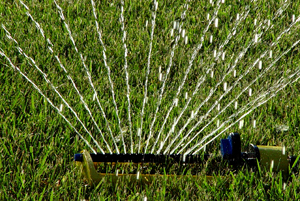Healthy Yard and Environment Tip: July
Water Your Lawn Correctly
Water deep and infrequently 
During hot summer months, water deeply once or twice per week. It promotes deep roots and maintains adequate soil moisture.
Deeply and infrequently is often the mantra that we hear. But just how deeply and how infrequently should you water? An adequate amount of water is definitely needed by plants to keep them healthy and beautiful. Under watering can cause turfgrass to overheat, go dormant, or even die.
However, too much water in the soil:
- Causes too little oxygen for the turf roots.
- Slow the uptake of nutrients
- Encourage diseases
- Promotes excessive growth of our plants — requiring more frequent mowing.
How deeply should you water?
Each time you irrigate your plants, you should apply enough water to wet the root zone of the plant. The best way to water is to soak the soil to a depth of 6 to 8 inches at such a rate that all the water is absorbed by the soil with no run-off.
It takes about an inch of water to penetrate about 8 inches into the soil, but some soils require more and some less. Poking a long screwdriver or rod into the soil will reveal the depth of water penetration. Moist soil can be easily penetrated and the probe will stop when it reaches dry soil.
Soak and Cycle Lawn Irrigation — Do You Soak and Cycle?
How infrequently should you water?
Watering frequency not only depends on the type of turf, it also depends on weather conditions, soil type and turf establishment. How do you know what’s right for your lawn? Observation of your lawn is the key. You will be surprised how long turf can go in between waterings before you see signs of stress. Wait until the grass shows signs of wilting, but not until severe wilting and browning of the foliage occurs.
The watering interval may vary form once every two or three weeks during the cool spring and fall weather to twice a week during dry periods in the summer.
An extreme case of over watering lawns is watering every day. This kind of watering schedule causes shallow rooting and the turf will not survive for more than a few days if water restrictions are imposed. Too much watering is not only wasteful but harmful to the turf. Frequent watering increases the chance of disease and shallow rooting hastens thatch buildup.
Water according to the weather
| Water Less | Water More |
| Cooler temperatures | High temperatures |
| Cloudy or overcast | Bright sunlight |
| Low wind | High wind |
| High humidity | Low humidity |
| Rain or showers | No rain |
Other K-State Resources
